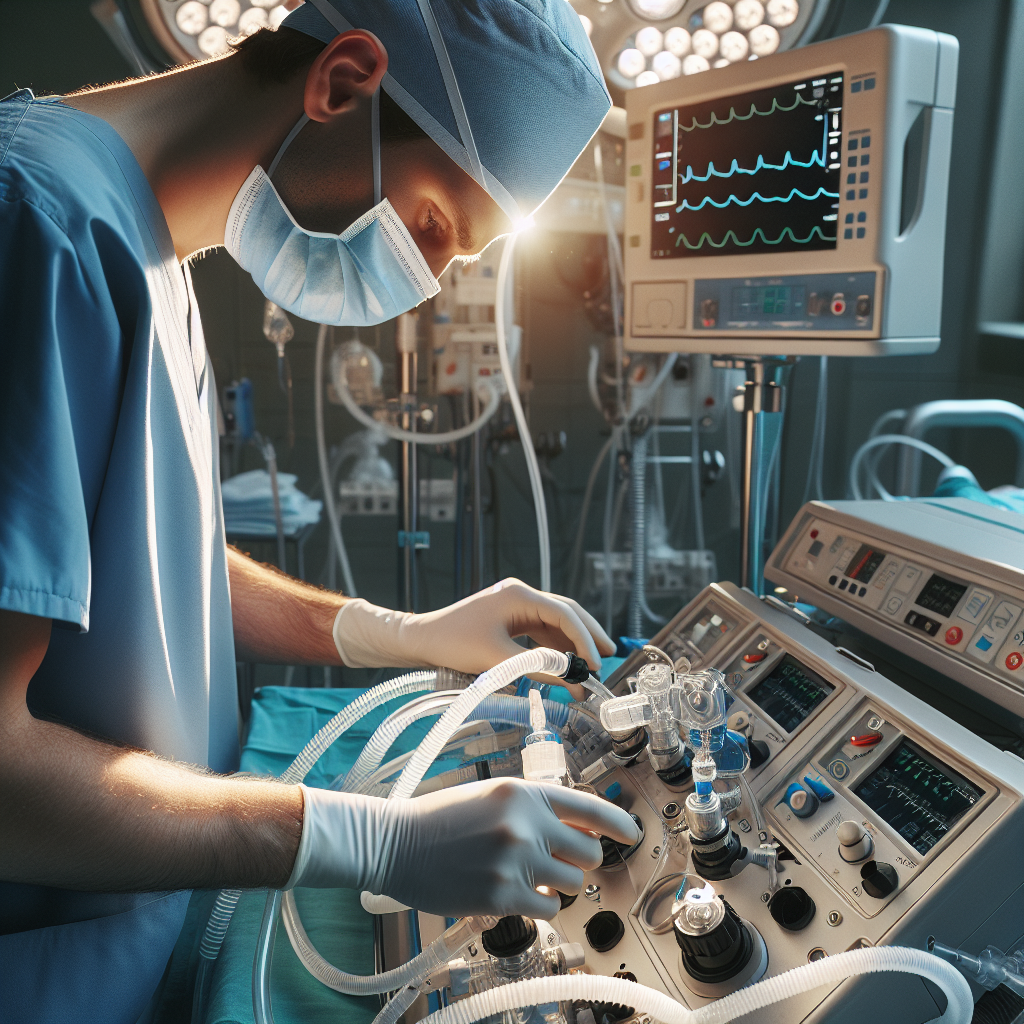The Ultimate Guide to Non-Rebreathing Anesthesia Machines: Operation, Maintenance, and Applications6 min read

Ensuring patient safety and optimal outcomes during surgical procedures requires a thorough understanding of anesthesia equipment. Non-rebreathing anesthesia machines play a crucial role in delivering precise concentrations of anesthetic gases while minimizing the risk of contamination. In this comprehensive technical guide, we’ll dive deep into the operating principles, maintenance requirements, and key applications of non-rebreathing anesthesia machines.
How Non-Rebreathing Anesthesia Machines Work
At the core of non-rebreathing anesthesia machines lies a sophisticated gas delivery system that ensures a continuous flow of fresh gas to the patient. Unlike rebreathing systems, which recirculate exhaled gases, non-rebreathing machines employ a unidirectional flow mechanism. This design prevents the mixing of exhaled and fresh gases, significantly reducing the risk of cross-contamination.
Gas Flow Mechanisms
Non-rebreathing anesthesia machines rely on precise gas flow control to deliver the desired concentrations of anesthetic agents. The fresh gas flow is typically regulated by a combination of flowmeters and vaporizers. Flowmeters allow for the adjustment of individual gas components, such as oxygen and nitrous oxide, while vaporizers introduce the volatile anesthetic agent into the gas stream.
Ventilation Systems
Proper ventilation is essential for maintaining optimal gas exchange and patient oxygenation. Non-rebreathing anesthesia machines incorporate advanced ventilation systems that provide precise control over respiratory parameters. These systems often include features such as pressure-controlled and volume-controlled ventilation modes, allowing anesthesiologists to tailor the ventilation settings to the patient’s specific needs.
Key Components of Non-Rebreathing Anesthesia Machines
To ensure the safe and effective operation of non-rebreathing anesthesia machines, it’s crucial to understand the key components and their functions. Let’s take a closer look at some of the essential elements:
Anesthesia Vaporizers
Anesthesia vaporizers are responsible for converting liquid anesthetic agents into a gaseous form that can be delivered to the patient. These precision devices maintain a constant vapor concentration, regardless of variations in gas flow or temperature. Modern vaporizers often feature advanced safety mechanisms, such as keyed filling systems and interlocks, to prevent accidental misuse or overfilling.
Carbon Dioxide Absorbers
Although non-rebreathing systems do not recirculate exhaled gases, they still incorporate carbon dioxide absorbers to remove any residual CO2 that may enter the fresh gas stream. These absorbers typically contain soda lime or other absorbent materials that chemically bind to carbon dioxide, ensuring that the patient receives a clean and safe gas mixture.
Breathing Circuits
The breathing circuit is the interface between the anesthesia machine and the patient. In non-rebreathing systems, the breathing circuit consists of a fresh gas inlet, an inspiratory limb, an expiratory limb, and a patient connection port. The design of the breathing circuit minimizes dead space and ensures efficient gas delivery to the patient.
Maintenance and Safety Considerations
Regular maintenance and adherence to safety protocols are essential for ensuring the reliable performance of non-rebreathing anesthesia machines. Here are some key considerations:
Routine Maintenance
Anesthesia machines require regular preventive maintenance to ensure optimal functionality and patient safety. This includes tasks such as calibrating vaporizers, replacing CO2 absorbent material, and inspecting breathing circuits for leaks or damage. Adhering to manufacturer-recommended maintenance schedules and using genuine replacement parts are crucial for maintaining the integrity of the equipment.
Leak Testing
Performing regular leak tests is an essential safety measure for non-rebreathing anesthesia machines. Leaks in the gas delivery system can lead to inadequate anesthetic delivery or even patient harm. Anesthesiologists should conduct thorough leak tests before each use, following the manufacturer’s guidelines and using appropriate testing devices.
Infection Control
Non-rebreathing anesthesia machines, although designed to minimize cross-contamination, still require stringent infection control measures. This includes using disposable or sterilizable components, such as breathing circuits and face masks, and properly disinfecting reusable parts. Adhering to established infection control protocols helps prevent the transmission of pathogens and ensures a safe environment for patients and healthcare providers.
Applications of Non-Rebreathing Anesthesia Machines
Non-rebreathing anesthesia machines find widespread use across various surgical specialties and settings. Some common applications include:
General Anesthesia
Non-rebreathing systems are commonly employed for general anesthesia in a wide range of surgical procedures. The precise control over anesthetic gas concentrations and ventilation parameters makes these machines well-suited for maintaining a safe and stable level of anesthesia throughout the operation.
Pediatric Anesthesia
Non-rebreathing anesthesia machines are particularly beneficial in pediatric anesthesia, where the avoidance of rebreathing and the ability to deliver high fresh gas flows are crucial. The unidirectional flow of gases reduces the risk of carbon dioxide accumulation and ensures optimal oxygenation for young patients.
Outpatient and Office-Based Procedures
The compact design and ease of use of non-rebreathing anesthesia machines make them well-suited for outpatient and office-based procedures. These settings often require efficient turnover times and the ability to provide safe anesthesia with minimal technical support. Non-rebreathing systems offer a reliable and cost-effective solution for these environments.
Frequently Asked Questions
What are the advantages of non-rebreathing anesthesia machines compared to rebreathing systems?
Non-rebreathing anesthesia machines offer several advantages over rebreathing systems. They minimize the risk of cross-contamination by preventing the mixing of exhaled and fresh gases. Non-rebreathing systems also allow for precise control over anesthetic gas concentrations and provide high fresh gas flows, which is particularly beneficial in pediatric anesthesia. Additionally, the unidirectional flow of gases reduces the risk of carbon dioxide accumulation and ensures optimal oxygenation for patients.
How often should preventive maintenance be performed on non-rebreathing anesthesia machines?
The frequency of preventive maintenance for non-rebreathing anesthesia machines may vary depending on the manufacturer’s recommendations and the specific model. However, as a general guideline, comprehensive maintenance should be performed at least annually. This includes tasks such as calibrating vaporizers, replacing CO2 absorbent material, and inspecting breathing circuits for leaks or damage. In addition to annual maintenance, regular checks and leak tests should be conducted before each use to ensure the machine’s proper functioning and patient safety.
Can non-rebreathing anesthesia machines be used for all types of surgical procedures?
Non-rebreathing anesthesia machines are versatile and can be used for a wide range of surgical procedures across various specialties. They are commonly employed for general anesthesia in both inpatient and outpatient settings. However, the choice of anesthesia machine ultimately depends on factors such as patient characteristics, surgical requirements, and the anesthesiologist’s preferences. In some cases, rebreathing systems or other specialized equipment may be more appropriate. It’s essential to assess each patient’s needs and consult with the anesthesia team to determine the most suitable equipment for a given procedure.
Conclusion
Non-rebreathing anesthesia machines are indispensable tools in modern anesthesia practice, offering precise control over gas delivery, minimizing the risk of contamination, and ensuring optimal patient safety. By understanding the operating principles, key components, and maintenance requirements of these machines, anesthesiologists can harness their full potential in providing high-quality anesthesia care.
This technical guide has provided a comprehensive overview of non-rebreathing anesthesia machines, covering their functionality, applications, and essential considerations for safe and effective use. As technology continues to advance, staying informed about the latest developments and best practices in anesthesia equipment is crucial for delivering exceptional patient outcomes.
